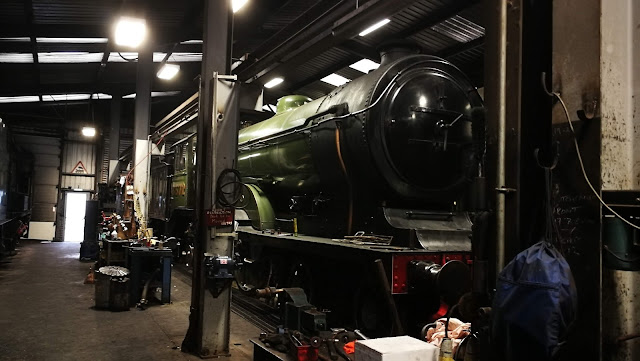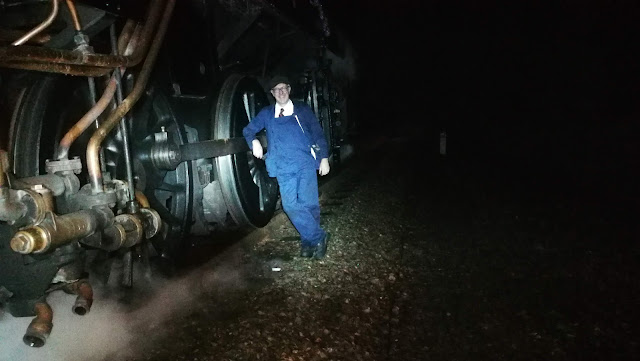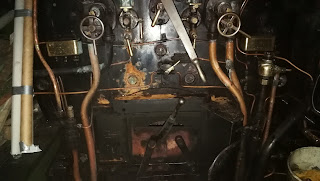Another Winter's day, another NLE turn. That will be a grand total of four Third Man NLE turns this year, all of which usefully show in my training schedule as night turns. They are quite easy, made more so by the fact that it has been pretty wet and railway policy is that you don't clean the loco in the wet, and there is not much point as no-one sees it in the dark.
This short sighted view was not shared by Ian, a regular visitor from Suffolk who was cleaning the 9F's wheels when I showed up; as usual, the loco was lit up so I set about cleaning the cab roof and chatting to the Duty Fitter Alan, about his Steam Roller among other things.
I made the fireman's checks:
There was plenty of coal on board, but it was all at one end of the tender. I climbed up and shoveled it all forward - probably a tonne or so. This must be good for my fitness???:
I really could have done more cleaning. Fireman Joe washed over the backhead with kerosene and steam oil, painted on with a brush; much better than I had left it:
We backed up to the pit to top up the axle boxes; I was bent double pumping oil while Driver Bryan topped up, and we chatted about Christmas plans. Following a full glass blow down (another demand for steam which the fireman must prepare for) we ashed out and I went beneath to wash down the brake rigging. I assisted Fireman Joe with the steam heat test, which involves opening the valves on the steam heat pipes at each end of the loco while the steam heat valve is opened to blow out the condensed water.
With Driver Bryan back and Fireman Joe off to get changed, we set back into the headshunt and headed off into Platform 2.
The service started slightly later than usual, as we did not have to go up the line to switch on the generators. I have no idea what I was thinking, but I managed to leave getting changed until very late - 3 minutes before departure, in fact. My usual watch was playing up, racing ahead gaining 15 - 20 minutes, probably from the vigorous shaking it got when shoveling coal. I'd also been playing close attention to the fire. Fortunately we had more than an hour to wait, warming the train before departure and it was a rather warm day for December anyway.
I fired down to Sheringham, building the fire gently - we needed steam for heating, but we didn't want to be blowing off. We arrived safe and sound, with the fire building. I added some water on the rise up Dead man's which was a mistake, as Driver Brian needed the steam for the hill. Better to use the injectors as we crested the hill, when you can see what is in the boiler and there is little demand for steam.
Next stop, Sheringham buffet. Another good lunch from Chef Nathan and a round of tea. At this point we have a few visitors to the footplate - it is great to get people on board taking pictures to remember their visit. The visitors are really one of the best bits of life on the railway.
As usual, Joe fired the first trip up to Holt building up a good fire - especially the horseshoe around the back & sides, which you must protect on these locos; I did the run around and fired back down to Sheringham.
There were masses of people arriving at Sheringham for the second train - it has been a really popular event:
I maintained my Fireman's role while Joe unhooked & we ran round. We took on 1000 gallons of water from the Sheringham crane; and we made our next and last round trip to Holt - Joe firing up, me firing back.
Back in Sheringham we waved our goodbyes and made our thank yous to the passengers, and went back to the water crane after run around. This time we were light engine and I fired from Sheringham up to Bridge 299 on Kelling Heath where we stopped to switch off the three generators. Keeping the fire as light as possible, I topped up the boiler on the way back to Weybourne. This time, I left it a bit light and while nothing went wrong it was low enough to warrant a prompt from Joe for me to do something about it before we ran out of steam too early. I guess as you are going to clean the fire anyway you can afford to arrive with plenty of fire - just not raging and building pressure when you want to go home.
My concentration shows in this picture - I'm waiting for the pressure to come around after laying on another round - and hoping it comes around enough for me to arrive on-shed with a full boiler!
On night turns, I've decided that I have a decent set of lights to guide the way. I use the Bardic when off the loco or when signalling, and this rechargeable LED torch when on the footplate:
It's got a magnet in the foot, which is strong enough to stay on the cab roof when moving - the arm has a single LED in the end which is bright enough to see the main pressure gauge the steam heat pressure gauges and the fireman's side water gauge yet it's not so bright as to ruin the driver's night vision:
It's got a very large LED array that I can use when I am tying on. You can place it on the end of the tender or on the loco buffer beam and shine it above the couplings & bags.
This turn is almost the last one of the 2019 season, and what a great start to my railway career it has been. I've one more turn on a Mince Pie Special on the 2nd January, and that will be it until next season.
This short sighted view was not shared by Ian, a regular visitor from Suffolk who was cleaning the 9F's wheels when I showed up; as usual, the loco was lit up so I set about cleaning the cab roof and chatting to the Duty Fitter Alan, about his Steam Roller among other things.
I made the fireman's checks:
- oil bottles - present and full, and the steam oil bottle on the warming plate
- two red flags in the locker
- burns kit on board
- two gauge glasses and seals
- water bucket filled
- tender tank full
- lamps fitted and working
There was plenty of coal on board, but it was all at one end of the tender. I climbed up and shoveled it all forward - probably a tonne or so. This must be good for my fitness???:
I really could have done more cleaning. Fireman Joe washed over the backhead with kerosene and steam oil, painted on with a brush; much better than I had left it:
We backed up to the pit to top up the axle boxes; I was bent double pumping oil while Driver Bryan topped up, and we chatted about Christmas plans. Following a full glass blow down (another demand for steam which the fireman must prepare for) we ashed out and I went beneath to wash down the brake rigging. I assisted Fireman Joe with the steam heat test, which involves opening the valves on the steam heat pipes at each end of the loco while the steam heat valve is opened to blow out the condensed water.
With Driver Bryan back and Fireman Joe off to get changed, we set back into the headshunt and headed off into Platform 2.
The service started slightly later than usual, as we did not have to go up the line to switch on the generators. I have no idea what I was thinking, but I managed to leave getting changed until very late - 3 minutes before departure, in fact. My usual watch was playing up, racing ahead gaining 15 - 20 minutes, probably from the vigorous shaking it got when shoveling coal. I'd also been playing close attention to the fire. Fortunately we had more than an hour to wait, warming the train before departure and it was a rather warm day for December anyway.
I fired down to Sheringham, building the fire gently - we needed steam for heating, but we didn't want to be blowing off. We arrived safe and sound, with the fire building. I added some water on the rise up Dead man's which was a mistake, as Driver Brian needed the steam for the hill. Better to use the injectors as we crested the hill, when you can see what is in the boiler and there is little demand for steam.
Next stop, Sheringham buffet. Another good lunch from Chef Nathan and a round of tea. At this point we have a few visitors to the footplate - it is great to get people on board taking pictures to remember their visit. The visitors are really one of the best bits of life on the railway.
As usual, Joe fired the first trip up to Holt building up a good fire - especially the horseshoe around the back & sides, which you must protect on these locos; I did the run around and fired back down to Sheringham.
There were masses of people arriving at Sheringham for the second train - it has been a really popular event:
I maintained my Fireman's role while Joe unhooked & we ran round. We took on 1000 gallons of water from the Sheringham crane; and we made our next and last round trip to Holt - Joe firing up, me firing back.
Back in Sheringham we waved our goodbyes and made our thank yous to the passengers, and went back to the water crane after run around. This time we were light engine and I fired from Sheringham up to Bridge 299 on Kelling Heath where we stopped to switch off the three generators. Keeping the fire as light as possible, I topped up the boiler on the way back to Weybourne. This time, I left it a bit light and while nothing went wrong it was low enough to warrant a prompt from Joe for me to do something about it before we ran out of steam too early. I guess as you are going to clean the fire anyway you can afford to arrive with plenty of fire - just not raging and building pressure when you want to go home.
My concentration shows in this picture - I'm waiting for the pressure to come around after laying on another round - and hoping it comes around enough for me to arrive on-shed with a full boiler!
On night turns, I've decided that I have a decent set of lights to guide the way. I use the Bardic when off the loco or when signalling, and this rechargeable LED torch when on the footplate:
It's got a magnet in the foot, which is strong enough to stay on the cab roof when moving - the arm has a single LED in the end which is bright enough to see the main pressure gauge the steam heat pressure gauges and the fireman's side water gauge yet it's not so bright as to ruin the driver's night vision:
It's got a very large LED array that I can use when I am tying on. You can place it on the end of the tender or on the loco buffer beam and shine it above the couplings & bags.
This turn is almost the last one of the 2019 season, and what a great start to my railway career it has been. I've one more turn on a Mince Pie Special on the 2nd January, and that will be it until next season.

































































